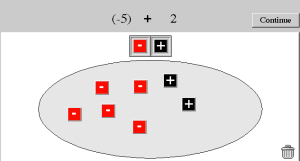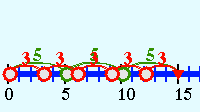We had a substitute teacher in class today, and I think she did pretty well with teaching the material. It made me realize that the same lesson can be taught in a very different way according to the instructor.
For the first half of the class, we went over lesson 5.1, which is integers. It involved the addition, subtraction, multiplication, and division of positive and negative numbers. We were taught two methods to use for this lesson.
The first was to use different colored tiles representing positive and negative numbers:

In this example the red tile represent negative numbers, and the black tiles represent positive numbers. We can visually solve the problem given above this way. In this problem, the answer is -3, because the 2 positive tiles cancel out with two negative tiles.
The second method was to use a number line:
 This is a visual representation of 3×5. On a number line, you would go up three groups of 5 or up 5 groups of 3 to get the answer, which is 15.
This is a visual representation of 3×5. On a number line, you would go up three groups of 5 or up 5 groups of 3 to get the answer, which is 15.
I found that colored tiles were more helpful for addition and subtraction, while a number line was more useful for multiplication and subtraction. When multiplying and dividing negative numbers, there are a few rules:
A•(-B)=(-K) and (-A)•B=(-K)
A÷(-B)=(-K) and (-A)÷B=(-K)
(-A)•(-B)=K and (-A)÷(-B)=K
This site provides a unique way to explain these multiplication an division rules.
The second half of the class focused on section 5.2, introduction to fractions. This lesson was focused mostly on the understanding of fractions in general and finding equivalent fractions. We used our fraction pieces to visually see how fractions can be equal.
 These pie graphs show that 1/2, 2/4, and 4/8 are all equal fractions because the same amount of each graph is shaded red.
These pie graphs show that 1/2, 2/4, and 4/8 are all equal fractions because the same amount of each graph is shaded red.
To know if one fraction is less than, greater than, or equal to another fraction, you can either visually compare the two fractions like this:

In this illustration, we can see that 2/4 is greater than 1/3. That would be written as 2/4>1/3.
To figure this out on your own, you will have to find the a common denominator. For 2/4 and 1/3, the least common denominator would be 12. So, you will have to multiply 2/4 by 3/3 and 1/3 by 4/4. You would get: 2/4=6/12 and 1/3=4/12. Now, you can find which fraction is larger- 6/12, or 2/4.
To practice this, go to this link.
The lesson for Monday covers operations with fractions.
Until then, have a great weekend!
~Ashley
Nice job Ashley! I feel like I was there! 🙂 maria